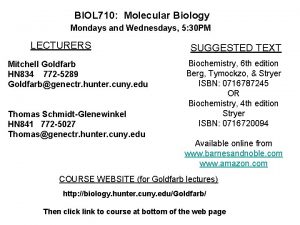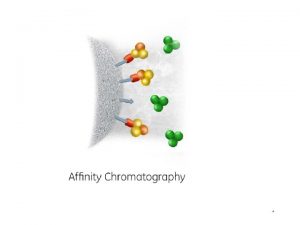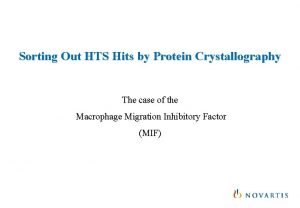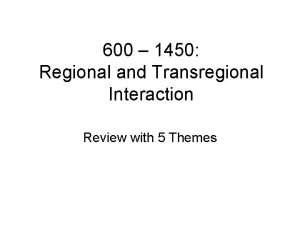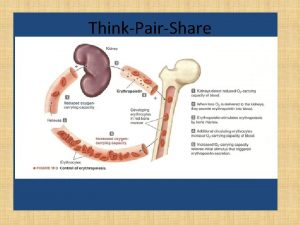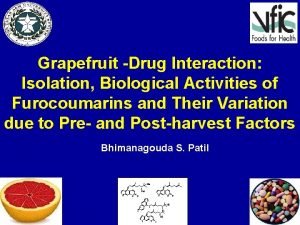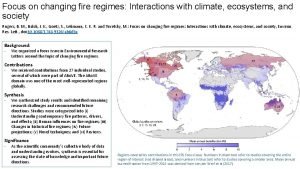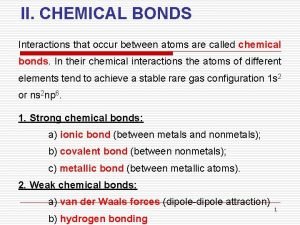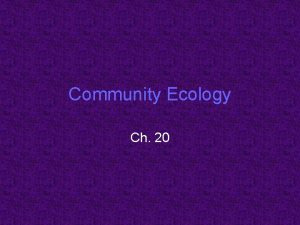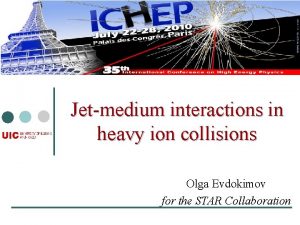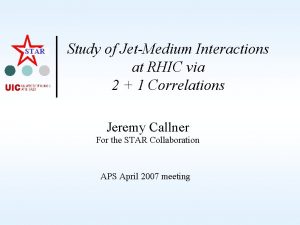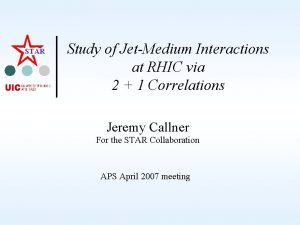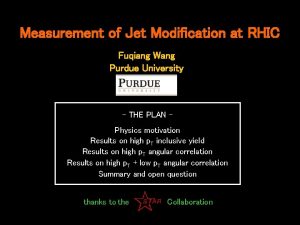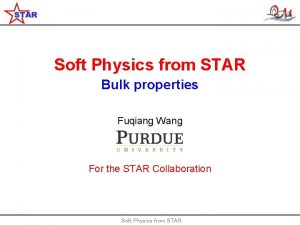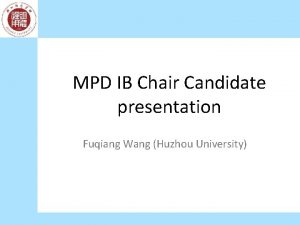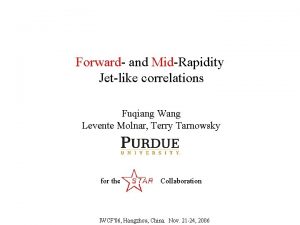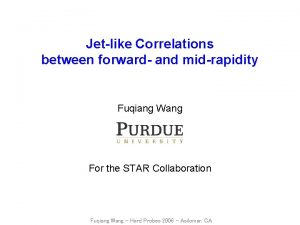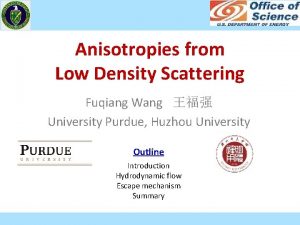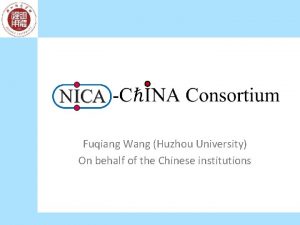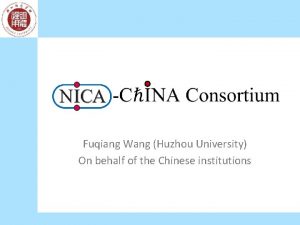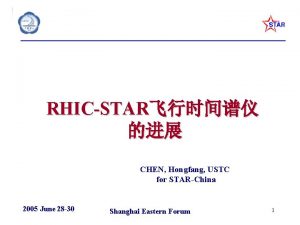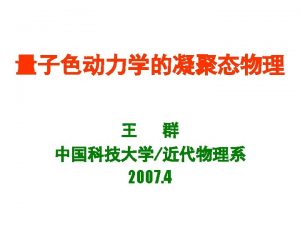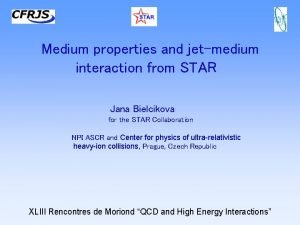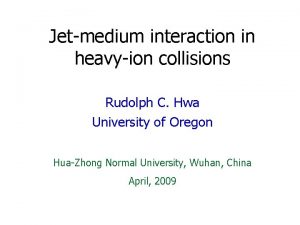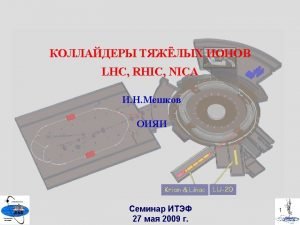JetMedium Interactions from RHICSTAR to LHCALICE Fuqiang Wang

















- Slides: 17

Jet-Medium Interactions from RHIC/STAR to LHC/ALICE Fuqiang Wang Purdue University What have been learnt at RHIC? What can be done at LHC?

Jet-like angular correlations have provided valuable information at RHIC. 4 < p. Ttrig < 6 Ge. V/c p. Tassoc > 2 Ge. V/c At high pt away-side is suppressed. 4 < p. Ttrig < 6 Ge. V/c 0. 15 < p. Tassoc < 4 Ge. V/c 8 < p. Ttrig < 15 Ge. V/c p. Tassoc > 2 Ge. V/c At low pt away-side is enhanced and broadened. At higher trigger pt away-side is reappearing. 2

Associated p. T spectra: experimental way to study thermalization processes. PRL 95, 152301 (2005). 4 < p. Ttrig < 6 Ge. V/c syst. error hard-soft parton interactions drive jet products and medium to equilibrate. 3

Full reconstruction of “jet” energy One may construct fragmentation functions for different centralities. pp 4

p. Ttrig=4 -6 Ge. V/c p. Tassoc=0. 15 -4 Ge. V/c Away side <p. T> (Ge. V/c) p. T-weighted correlation number correlation <pt> can be studied in greater detail. path-length effect? conical flow? deflected jets? 5

centrality dependence of <p. T> near Away side <p. T> (Ge. V/c) Leading hadrons <p T> fro ma away wa Medium y je ts ecay md <p. T> from mediu 6

baryon/meson anomaly Coalescence/recombination models are very attractive. But baryon and meson trigger correlations are not much different. 7

With the emerged away-side jet, we can do trior quad-hadron correlations! Away-side fragmentation patterns appear unchanged with centrality. Are they the fraction of partons that escaped without interactions? Reconstruct the away-side jets including low p. T. Dan Magestro 8

All these studies can be carried out at LHC/ALICE, and better. • ALICE best suited for “semi-hard” region: probably where most of the jet-quenching actions take place. • Large p. T coverage: full reconstruction of jets. Jetfragmentation studies. • background increase (x 2) from RHIC to LHC. But huge increase in highp. T statistics. • unique PID capabilities. • larger statistics: multidimensional studies. 9

And even better… with triggering! • g (PHOS/EMC) + jet (TPC) g (EMC) + p 0 (PHOS) g (PHOS) + jet (EMC) – both surface and volume emission. – full reconstruction of away-side jets. energy balance? medium-energy pick-up? – modified jet-fragmentation functions. • g (PHOS/EMC) + e± (TPC) g (PHOS) + e± (EMC) – heavy-flavor energy loss 10

Conical flow? trigger pt =2. 5 -4. 0 Ge. V/c, associated pt =1. 0 -2. 5 Ge. V/c Jason Ulery PHENIX: |h|<0. 35 STAR: |h|<0. 35 Mark Horner 0 -5% 5 -10% 10 -20% 20 -40% 40 -60% 60 -80% STAR Preliminary 11

Three-particle correlations? near Df 2 J B Medium away mach cone near Df 2 Df 1 T(J+B)1(J+B)2 = (TJ 1 J 2) + (TJ 1)B 2 + (TJ 2)B 1 + T(B 1 B 2) = B 1 B 2 = flow modulated background Medium away deflected jets + SS (soft-soft correlation in Background) Df 1 12

3 -particle correlation analysis 3 < p. Ttrig < 4 Ge. V/c, 1 < p. Tassoc < 2 Ge. V/c, Au+Au 0 -10% Raw signal: T(J+B)1(J+B)2 flow modulated background STAR Preliminary soft-soft correlation Hard-Soft-bkgd: (TJ 1)B 2 + (TJ 2)B 1 bkgd-bkgd: B 1 B 2 13

effect of v 2 on 3 -particle correlation 1/Ntrig d 2 N/d(Δφ1)d(Δφ2) 3 < p. Ttrig < 4 Ge. V/c, 1 < p. Tassoc < 2 Ge. V/c, Au+Au 0 -10% average of 4 particle cumulant v 2 and reaction plane v 2 STAR Preliminary 4 particle cumulant v 2 reaction plane v 2 correlation result is robust with v 2. 14

pp and d+Au results 1/Ntrig d 2 N/d(Δφ1)d(Δφ2) 2 < p. Ttrig < 4 Ge. V/c, 1 < p. Tassoc < 2 Ge. V/c ppΔφ STAR Preliminary d+Au 3 < p. Ttrig < 4 Ge. V/c, 1 < p. Tassoc < 2 Ge. V/c Δφ Appears elongated along the diagonal axis in d+Au, possibly due to k. T broadening away near s. S/2 = 0. 89 ± 0. 11 s. D = 0. 69 ± 0. 05 s. D = 0. 66 ± 0. 07 d+Au Δφ 15

conical flow? 3 -particle correlation p. Ttrig=3 -4, p. Tassoc=1 -2 Ge. V/c 2 -particle corr, bg, v 2 subtracted d+Au and Au+Au elongated along diagonal: d+Au min-bias Dφ2=φ2 -φtrig k. T effect, and deflected jets? Three regions on away side: center = (p, p) ± 0. 4 corner = (p+1, p+1) ± 0. 4 x 2 cone = (p+1, p-1) ± 0. 4 x 2 d. N 2/dΔφ1 dΔφ2/Ntrig Dφ2=φ2 -φtrig Au+Au 10% difference in Au+Au average signal per radian 2: center – corner = 0. 3 ± 0. 3 (stat) ± 0. 4 (syst) center – cone = 2. 6 ± 0. 3 (stat) ± 0. 8 (syst) Distinctive features of conical flow are not seen in present data with these p. T windows. Dφ1=φ1 -φtrig 16

Three-particle correlations can be done at LHC, also much better. may have to be limited at low-modest p. T (need 2 associated particles). 17
 Molecular biology
Molecular biology Protein binding interactions
Protein binding interactions Role of quantitative research
Role of quantitative research Hccee
Hccee Regional and transregional interactions
Regional and transregional interactions Chapter 22 reaching out cross-cultural interactions
Chapter 22 reaching out cross-cultural interactions Interactions among living things
Interactions among living things Integral vs modular architecture
Integral vs modular architecture Organization of the lymphatic system
Organization of the lymphatic system Grapefruit-drug interactions chart
Grapefruit-drug interactions chart Congress formal and informal powers
Congress formal and informal powers Interactions
Interactions Cholinomimetic
Cholinomimetic Interactions between ais and internal and external parties
Interactions between ais and internal and external parties Interactions between atoms occur
Interactions between atoms occur Symbiosis and species interactions keystone webquest
Symbiosis and species interactions keystone webquest Section 20-1 review species interactions
Section 20-1 review species interactions Ppi drug interactions
Ppi drug interactions
